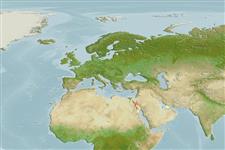>
Gobiiformes (Gobies) >
Gobiidae (Gobies) > Gobiinae
Etymology: Gobiodon: Latin, gobius = gudgeon + Greek, odous = teeth (Ref. 45335); ater: Named for its uniformly black life colouration, including the eye; from the Latin words 'ater' for black.
Environment: milieu / climate zone / depth range / distribution range
Ecologia
marinhas associadas(os) a recifes. Tropical
Indo-West Pacific, Red Sea.
Tamanho / Peso / Idade
Maturity: Lm ? range ? - ? cm
Max length : 2.7 cm SL macho/indeterminado; (Ref. 94082)
Descrição suscinta
Chaves de identificação | Morfologia | Morfometria
Espinhos dorsais (total) : 7; Raios dorsais (total) : 10; Espinhos anais: 1; Raios anais : 8. This species is distinguished by the following characters: D VI+I,10; A I,8; head and body are naked; presence of a deep curved groove on isthmus; body and caudal peduncle slender (depth 37-41.2% and 13.8-14.7% SL, respectively); juveniles with rounded head, large adults slightly hump-headed; colour in juveniles and adults uniformly black, including iris; very small species (< 2.8 cm SL); females of breeding pairs usually significantly larger than males, recorded smallest highly gravid female is 1.85 cm SL (Ref. 94082).
Facultative air-breathing in the genus (Ref. 126274); This species is found in shallow water regions such as protected reef flats and reef crests. It is highly specialized and prefers fine-branched corals such as Acropora selago and small tabulate colonies of Acropora hyacinthus. Seldom occurs in other Acropora species, such as A. acuminata, A. samoensis, A. eurystoma and A. valida. Due to its black colouration it is sometimes difficult to detect within the dark interstices of narrow-branched Acropora colonies (Ref. 94082).
Ciclo de vida ou comportamento de acasalamento
Maturidade | Reprodução | Desova | Ovos | Fecundidade | Larvas
Herler, J., S.V. Bogorodsky and T. Suzuki, 2013. Four new species of coral gobies (Teleostei: Gobiidae: Gobiodon), with comments on their relationships within the genus. Zootaxa 3709(4):301-329. (Ref. 94082)
Status na Lista Vermelha da UICN (Ref. 130435: Version 2024-1)
Ameaça para os humanos
Harmless
Uso pelos humanos
Ferramentas
Relatórios especiais
Baixar XML
Fontes da internet
Estimates based on models
Preferred temperature (Ref.
123201): 24.9 - 27.2, mean 26.7 °C (based on 18 cells).
Índice de diversidade filogenética (Ref.
82804): PD
50 = 0.5000 [Uniqueness, from 0.5 = low to 2.0 = high].
Bayesian length-weight: a=0.01995 (0.00906 - 0.04395), b=3.01 (2.83 - 3.19), in cm total length, based on all LWR estimates for this body shape (Ref.
93245).
Nível Trófico (Ref.
69278): 3.2 ±0.4 se; based on size and trophs of closest relatives
Resiliência (Ref.
120179): Elevada, tempo mínimo de duplicação da população menor que 15 meses (Preliminary K or Fecundity.).
Fishing Vulnerability (Ref.
59153): Low vulnerability (10 of 100).
